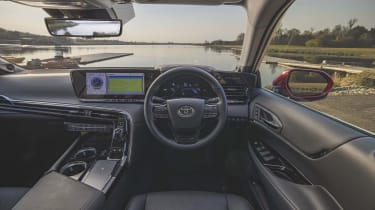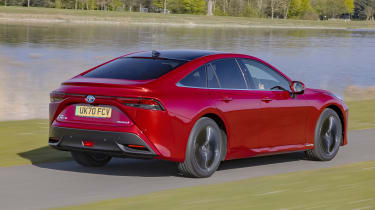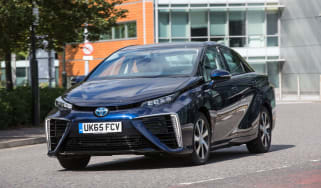Toyota Mirai review
The second-generation Toyota Mirai hydrogen fuel-cell car has been improved in every area – but not enough to overcome its £50k starting price and the cost of refuelling it
Pros
- Comfortable
- Luxurious cabin
- Silent town driving
Cons
- Price of refuelling
- Limited rear headroom
- Poor hydrogen infrastructure
| Car type | Driving range | CO2 emissions | 0-62mph |
|---|---|---|---|
| Hydrogen fuel-cell | 400 miles | 0g/km | 9.0s |
Back in 2015, Toyota launched the first-generation Mirai – a purpose-built hydrogen fuel-cell vehicle with an eye firmly on the future rather than any big sales targets. Six years later, The Japanese company revealed an all-new version – and it’s a much more serious contender than what came before.
Toyota calls this a holistic approach to electrification. While the Mirai isn’t an electric car in the conventional sense, it feels broadly similar to many mainstream EVs in the way it drives. The big difference is range and refuelling time – if you’ve got the means to do so, you can fill the Mirai in around five minutes, returning a range of roughly 400 miles.
But therein lies this car’s biggest issue, as hydrogen infrastructure in the UK remains sparse, with just a handful of stations nationwide. This would make driving a car like the Mirai from London to Cornwall incredibly difficult; you can’t just plug it in if you run out of fuel. But if you live near a pump and it fits your lifestyle, should you consider one over a similarly priced electric car?
The first thing you notice about this latest Mirai is how much more cohesive the design is than the old model's. Style is subjective, but the second-generation car has more in common with something like an Audi A7 than it does the upright and slightly frumpy original. The same is true inside; the Mirai feels much more luxurious – you sit lower and the plush materials and widescreen infotainment give it upmarket appeal.
That infotainment setup is still hampered by Toyota’s clunky interface and dated graphics, but thankfully it's now compatible with Apple CarPlay and Android Auto, which come as standard across the range. This allows you to access the contents of your phone – including mapping, media and calls – without needing the in-built menus. Elsewhere, the separate climate controls are easy to access and while the digital dials are clear, they’re lacking a little in functionality.
Push the starter button and you’re greeted by the sound of silence. In fact, this sense of calm continues right up to motorway speeds – the Mirai is incredibly quiet and refined, plus compliant suspension gives it a ride quality more akin to a modern Mercedes than an eco-friendly family car.
Thankfully, that comfort doesn’t come at the expense of the rest of the driving experience. This is no sports car by any stretch of the imagination, but it handles neatly with plenty of control and accurate steering. The brakes are good, too; the Mirai isn’t plagued by the inconsistent pedal feel found in many modern electric cars. The tradeoff is that there's little in the way of regenerative braking, even in the gearbox’s ‘B’ mode.
This latest Mirai is 12% more powerful than the car it replaces, and while 172bhp may not sound like much, the nature of the power delivery means straight-line performance is strong. It won’t bend your mind like the fastest EVs, but the Mirai is certainly quick enough for commuting and even the odd impromptu overtake.
As well as being more powerful, the Mk2 Mirai is also a bit bigger than the old car. In theory that should work wonders for space and practicality, but in reality there’s not a huge amount of room inside for rear-seat passengers. There's a recess in the roof to improve headroom, but taller adults will struggle to get truly comfortable. The boot is also compromised by a saloon-style opening and shallow depth.
Then there’s the cost of buying and running a Mirai. Prices for the entry-level Design car start at £49,995, with the top-spec model costing an eye-watering £64,995. Every model gets a generous level of kit, including 19-inch alloy wheels, a 12.3-inch infotainment screen, 14-speaker JBL stereo and heated front seats.
Toyota expects the Design Plus (£53,995) to be the most popular, thanks to its synthetic leather seats, panoramic rear-view camera and extra safety features. Top-spec cars gain 20-inch wheels, ventilated leather seats, a digital rear-view mirror and a panoramic roof among other items. Quality is excellent throughout.
But once you’ve stomached the high purchase price, the cost of fuelling the Mirai will be on par with an electric car, right? Unfortunately not; hydrogen currently retails for around £10 per kilo, meaning the Mirai’s 5.6kg tank will cost more than £50 to fill. For a range of around 400 miles, that’s closer to a conventional petrol or diesel car than an electric one – even if you don’t take advantage of off-peak domestic electricity.
Of course, the fact the Mirai emits only water means that it qualifies for the very lowest company-car tax rates; Toyota claims the Mirai is better than net zero, in fact – removing harmful SO2 and NOx pollutants from the air as it drives. It’s exempt from road tax and the London Congestion Charge, too.
The strides Toyota has made from the old Mirai to this latest generation are significant, but the limitations remain. It’s a shame, because in isolation this car is a talented all-rounder. Its sleek looks, premium interior, and luxurious, cosseting driving experience make it feel almost as if it should have a Lexus badge on the nose, rather than the humble Toyota emblem. For the time being, though, a comparable electric car will still be cheaper to buy, cheaper to run, and for many, much easier to live with.








